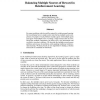60
Voted
NIPS
2000
15 years 2 months ago
2000
75
Voted
NIPS
2000
15 years 2 months ago
2000
We analyze the bit error probability of multiuser demodulators for directsequence binary phase-shift-keying (DS/BPSK) CDMA channel with additive gaussian noise. The problem of mul...
88
Voted
NIPS
2000
15 years 2 months ago
2000
Modern classification applications necessitate supplementing the few available labeled examples with unlabeled examples to improve classification performance. We present a new tra...
92
Voted
NIPS
2000
15 years 2 months ago
2000
We propose a method of approximate dynamic programming for Markov decision processes (MDPs) using algebraic decision diagrams (ADDs). We produce near-optimal value functions and p...
73
Voted
NIPS
2000
15 years 2 months ago
2000
89
Voted
NIPS
2000
15 years 2 months ago
2000
We have developed a silicon neuron that is inspired by a mathematical model of the leech heartbeat (HN) interneuron. The temporal and ionic current behaviors of this silicon neuro...
66
Voted
NIPS
2000
15 years 2 months ago
2000
For many problems which would be natural for reinforcement learning, the reward signal is not a single scalar value but has multiple scalar components. Examples of such problems i...
NIPS
2000
15 years 2 months ago
2000
The principle of maximizing mutual information is applied to learning overcomplete and recurrent representations. The underlying model consists of a network of input units driving...
59
Voted
NIPS
2000
15 years 2 months ago
2000
63
Voted
NIPS
2000
15 years 2 months ago
2000
A method is described which, like the kernel trick in support vector machines (SVMs), lets us generalize distance-based algorithms to operate in feature spaces, usually nonlinearl...

